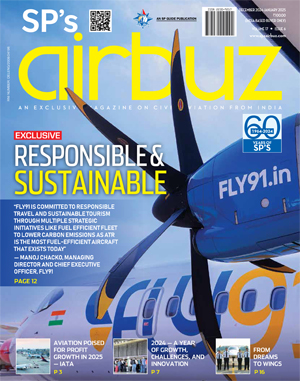Transport - Connecting Northeast

On the anvil are Central Government’s plans to purchase small aircraft (26-30 seats) to meet the specific requirements of the region. Private operators would also be welcomed to operate small or regional aircraft to and within the Northeast region.
Home to some of the most picturesque locations of the country, the North-eastern Region (NER) of India comprises eight states; Arunachal Pradesh, Assam, Manipur, Meghalaya, Mizoram, Nagaland, Sikkim and Tripura. However, the very reason for the region’s splendour, its mountainous terrain, has also been an impediment to its development. Indeed, in recognition of this, a North Eastern Council (NEC) was set up in 1971 by an Act of Parliament as the nodal agency to speed up the economic and social development of the region. In 2008, the Northeastern Region Vision 2020 document was released by Prime Minister Manmohan Singh. To translate the vision document into a reality, a high level inter-ministerial group was constituted to provide guidelines and supervise the strategies and progress for inter-sectoral mobilisation in the region. However, the pace of development remains slow with aviation being the sector with the slowest growth rate.
Operational Inadequacies and Hazards. Aviators operating in the Northeast region adhere to the philosophy that one can take chances with either the hills or the weather, but it is suicidal to take chances with the weather and the hills at the same time. The NER presents immense potential for this deadly combination which on April 30 this year, claimed the lives of Arunachal Pradesh Chief Minister Dorje Khandu and four others in a helicopter crash at Luguthang while flying between Tawang and Itanagar. Expected knee-jerk reactions included a decision to “map helicopter routes” (whatever that means) and suspending operations in the region by Pawan Hans. Most states later restored services by Pawan Hans with twin-engine helicopters only. Meghalaya floated a fresh tender for helicopter services. The accident served to bring to the fore the logistical challenges in the Northeast region. The terrain is largely rugged and inaccessible due to sharp contours and thick forests with the Brahmaputra and several other fast-flowing rivers making travel by land route arduous and time consuming. Road and rail networks are underdeveloped and serve only the lower reaches of extensive mountain tracts.
Movement of personnel and material by air though a necessity is beset by difficulties. Given the lack of navigational facilities and persistent bad weather, flying in the different valleys that appear identical, requires intimate knowledge of the terrain on the part of the air crew to obviate the possibility of flight into terrain. Besides, as most of the states have international borders, there is the added risk of inadvertently crossing over into alien air space. Difficulties for aviators are further compounded by the fact that the aircraft is usually being operated at the fringes of its critical limitations with reduced safety margins.
There are other problems too. Pilots flying between Kolkata and airports in the Northeast region often gripe about inadequate radar cover and the lack of communication between the air traffic controller (ATC) at Kolkata and Dhaka. This is a serious problem as flights transit through Bangladesh airspace. The pilots attribute the problems to the archaic air traffic surveillance systems which do not cater to the increase in volume of traffic over the past few years. A flight departing from Kolkata enters Bangladesh after flying barely 30 nautical miles within Kolkata flight information region. The aircraft then covers around 100 nautical miles before entering the NER, where it covers another 25 to 150 nautical miles depending on the destination. The poor interaction between ATCs at Kolkata and Dhaka has a potential for communication gaps with attendant implications. Pilots try to keep the ATC informed about their flight details but there have been several instances of a near-miss.
With the only radar available at Guwahati, radar cover available to civil aircraft is inadequate. Clamour for enhanced radar cover in the region has fallen on deaf ears so far. The mountainous terrain is also inclined to inhibit radio communication. Pilots are compelled to resort to indirect or circuitous routes to communicate with the area control at Guwahati. In short, flying into, out of and within the NER can be stressful.
Air Connectivity
Without doubt, air connectivity of the Northeast region with the rest of the country leaves much to be desired. Although the ‘chicken’s neck’ area lies in West Bengal, Assam is the real gateway to the NER. Guwahati is connected by commercial air routes to New Delhi, Kolkata, Mumbai, Chennai and Bagdogra and through these airports to all major cities in India. Within the region, there is air connectivity with the state capitals but the frequency of scheduled flights remains low as airlines are reluctant to enhance the frequency of services. Their reluctance is attributable to a decision by the Ministry of Civil Aviation (MoCA) that operations to any airport in the NER once commenced cannot be withdrawn without the express permission of MoCA. As such permission is not easily granted, airlines remain wary of commencing operations to the Northeast region as it may be difficult to cease operations if they prove to be lossmaking. Nevertheless, in response to a decade-old demand for developing Guwahati as a regional aviation hub, Air India plans to shift a major portion of its operational and maintenance activities from Kolkata to Guwahati with the intent of enhancing connectivity to remote parts of NER. While helping Air India increase its market share, this endeavour will also bring on to the air map some areas of the region that are not connected to any of the metros as of now. Guwahati will thus get better linked to the whole of NER. Induction of some additional CRJ-700 jets and turboprop ATRs is expected to help fructify this plan. These two, essentially regional aircraft, have lower operating cost because of the concessional landing/parking charges and lower tax on aviation fuel.
Non-Scheduled Operators
Coming to non-scheduled operations, again the region has had less than its proportionate share of charter operators. Despite an attractively low sales tax on aviation fuel, the lowest in the country and state government subsidies on offer, only a couple of charter operators have ventured into the Northeast region. Northeast Shuttles, a Tripurabased venture, is one such success story. Having launched operations in 2009 with a nine-seat Cessna Caravan, it has since added two 18-seat Dornier 228 to its modest lineup and is scouting around for a bigger aircraft. It offers passenger and cargo charters in addition to emergency medical services (EMS) in the NER. However, despite the huge demand for intra-region connectivity, charter services have been sparse.
Spurring the Growth of Regional Aviation. So is there something to cheer about as far as aviation in the Northeast region is concerned? Fortunately, yes. The Union Minister for Development of the Northeast Region (DoNER) B.K. Handique has recently taken the initiative of producing a new policy document on civil aviation entitled “Multi-Utility Aviation in the Northeast Region—An Alternative Innovative Model For Hastening Development”. It highlights the fact that the “chicken neck” that connects the NER with the rest of India territorially in effect only connects two states, Assam and Sikkim. It emphasises that this narrow strip of land is choked not just by a high-density population but by roads, railway lines, cables, oil pipelines and power lines. It goes on to iterate that the “inclusiveness of the NER with the rest of India is physically possible only through air services.” The document’s objective is to improve safety standards, increase frequency and connectivity and thus reduce the physical isolation of the region. Hoping to integrate the Northeastern perspective into the national civil aviation policy, the Minister took up the issue with the Minister of Civil Aviation, Vayalar Ravi, wherein the latter is reported to have agreed in principle to develop Guwahati, Agartala, Imphal and Dibrugarh airports as regional hubs.





